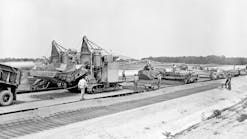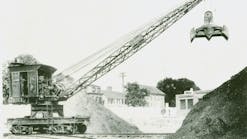As in any successful business venture, costs have to be kept as low as possible, and using equipment that can do the most work at the least cost is key to achieving this goal. Earthmoving, in particular, often benefits from economies of scale, with machines that can move the most material at one time often being preferred—but not always. Although the largest available machine will be the most productive, all else being equal, the larger machine also will incur costs that smaller machines do not.
Large draglines—those models larger than their counterparts commonly found in construction—were perfect examples of this. Walking draglines are highly efficient excavating machines, but unsuitable for the vast majority of construction work.
Besides costing more to purchase than smaller draglines, the larger models also are much more expensive to move from project to project, requiring considerable disassembly and reassembly during a move, as well as numerous transport trucks or railcars to relocate disassembled components. In construction, these large models have to be relocated every couple of years as projects are completed, incurring all those costs with each move. They are, however, ideally suited for mining applications, in which they typically stay on one site for years on end.
Consider the case of Western Contracting Corp. The company had established itself in the early 20th century as a road contractor in the upper midwestern states, but in the mid-1940s expanded into large-scale earthmoving work—for which it became best known for the next 20 years.
Part of this work involved two sections of the Delta-Mendota Canal in central California. On the first project, awarded in 1946, a Marion 7200 8-cubic-yard walking dragline handled most of the excavation; four years later, on the second section, the Marion joined forces with another 7200 to do most of the digging. The two 7200s were retired (1952 and 1954) and replaced by Marion 191-M electric shovels and draglines—the largest excavators on two crawlers at the time. For reasons unknown to this author, Western only rarely ventured into the logical application for these machines, mine stripping, and then only years later.
When in 1964 and 1965 Western successfully bid two sections of the California Aqueduct, not far from the Delta-Mendota work of the 1940s, it again chose to use draglines to handle much of the excavation on one of the jobs. Two of the 191-Ms, wielding 14-cubic-yard buckets, divided the work with a fleet of Euclid Tandem-14 twin-bowl motor scrapers.
That fact helps explain the demise of oversized draglines in heavy construction excavation. In the 1940s, major canals were tailor-made for big draglines. But scraper size and technology had advanced considerably since then, so scrapers handled the vast majority of excavation for the Aqueduct. Indeed, this author knows of only one other large dragline, a walking dragline, comparable in size to the 191-Ms, used by the Morrison-Knudsen/Utah Construction & Mining joint venture in 1963 and 1964 on the California Aqueduct. Two 191-Ms, a shovel and a dragline, went on to work for Western at Castaic Dam north of Los Angeles in the late 1960s.
The Historical Construction Equipment Association (HCEA) is a 501(c)3 non-profit organization dedicated to preserving the history of the construction, dredging, and surface-mining equipment industries. With more than 4,000 members in 25 countries, our activities include publication of a quarterly educational magazine, Equipment Echoes; operation of the National Construction Equipment Museum and archives in Bowling Green, Ohio; and hosting an annual working exhibition of restored construction equipment. Our 2017 show will be November 3-5 at the Ederville Train and Tractor Show, Carthage, N.C. Individual memberships within the USA and Canada are $35 for one year, $66.95 for two years, $99.95 for three years, and $45.00 US elsewhere. We seek to develop relationships in the equipment manufacturing industry, and we offer a college scholarship for engineering and construction management students. Information is available at www.hcea.net, or by calling 419.352.5616 or e-mailing [email protected]. Information about the project described in this column is from the July, 1967, issue of Roads & Streets magazine.





